 The
following article written by James C. Rautio is a thorough and
concise description of the life and accomplishments of James Clerk
Maxwell and what led him to the exposition of his famous laws
of electromagnetism. It was previously published in the IEEE Microwave
Theory and Techniques Society Magazine. Jim Rautio is with Sonnet
Software in Syracuse, New York, which is one of the leading producers
of software for numerical analysis of electromagnetics (EMC) problems.
Everything we do in the discipline of EMC as well as in a myriad
of uncountable other applications is governed by these laws which
are generally referred to as “Maxwell’s Equations”.
The
following article written by James C. Rautio is a thorough and
concise description of the life and accomplishments of James Clerk
Maxwell and what led him to the exposition of his famous laws
of electromagnetism. It was previously published in the IEEE Microwave
Theory and Techniques Society Magazine. Jim Rautio is with Sonnet
Software in Syracuse, New York, which is one of the leading producers
of software for numerical analysis of electromagnetics (EMC) problems.
Everything we do in the discipline of EMC as well as in a myriad
of uncountable other applications is governed by these laws which
are generally referred to as “Maxwell’s Equations”.
As a Distinguished Lecturer for the MTT Society, he chose the
topic of “The Life of James Clerk Maxwell.” It is
important for students and practitioners to know the history of
electrical engineers who have made substantial contributions to
our profession. These early researchers performed their experiments
using the crudest of experimental apparatus by today’s standards.
Yet, the fundamental laws they formulated have remained unchanged
for 200 years!
We often lose sight of the fact that in every aspect of our daily
EMC work we are “solving Maxwell’s equations.”
Perhaps this is because we can often “get away with”
using lumped circuit ideas (Ohm’s law) and Kirchhoff’s
laws and don’t appear to be solving Maxwell’s equations
when in fact we are. These are approximations to Maxwell’s
equations valid only where our circuits are electrically small
(i.e., maximum physical dimensions much less than a wavelength).
With digital processor clock and data speeds today entering the
gigahertz range and risetimes/falltimes of the pulses in the sub-nanosecond
range, these lumped-circuit notions often do not work any longer
since the circuits dimensions (such as PCB land lengths) are becoming
electrically long. The physical dimensions of PCBs and the lands
on them have not changed substantially, but the spectral content
of the signals carried by them has! Therefore, in the electronics
of the future we have no choice but to give Maxwell’s equations
a fresh look. Hence, it is fitting that our science has come around
again to these fundamental laws of Maxwell. EMC
 An
Introduction to James C. Rautio’s Article on James Clerk Maxwell
An
Introduction to James C. Rautio’s Article on James Clerk Maxwell